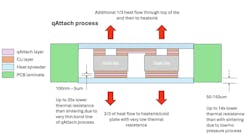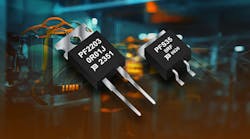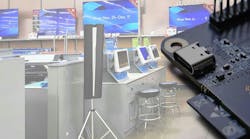Die-Attach Process Dramatically Improves Waste-Heat Removal in Power Electronics
QPT just filed a patent for the “qAttach” process, a novel way to attach dies to heat spreaders or substrates (typically aluminum nitride (AlN)) that significantly reduces thermal resistance. The new assembly process also boosts reliability as it places less stress on the substrates.
Developed by QPT for use with the gallium-nitride (GaN) transistors used in its electric motor-control designs, qAttach enables the devices to more efficiently dissipate the large amounts of waste heat they generate when using them for high-power, high-voltage applications and at high frequency.
Heat removal is especially challenging for high-voltage GaN transistors because their die size is relatively small, which means there’s less surface area to remove heat from. The conventional die-attach technology is based on a sinter layer, typically 30 to 60 µm thick, which presents a relatively poor thermal path between the bottom of the die and the heatsink.
In a different approach, qAttach, which is based on a bonding material, can be applied to the top and bottom of the chip in films as thin as a single micron. The film’s low thermal resistance enables heat to be efficiently removed by a heatsink on the top of the die and by a heavy copper layer on the PCB below it. This increases thermal conduction by up to 15X, versus devices attached using conventional single-sided bonding methods. As a result, it becomes easier to use GaN devices in next-generation, high power, high-voltage applications in automotive and industrial motors.
qAttach also improves the reliability of inverter bridge modules and other assemblies containing power transistors. It does so by reducing the amount of mechanical stress the die is subjected to during the attachment process.
Reliability is further enhanced because the ultra-thin qAttach layer isn’t a laminar sheet. It has a proprietary geometry that constrains expansion predominantly in the Z axis, which is perpendicular to the qAttach layer, when heated. This virtually eliminates potential delamination of the attach layer from the die and substrate—the largest cause of failures in conventional power packages.






